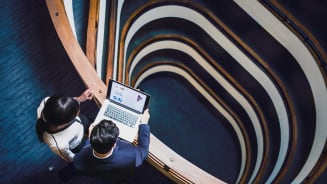Across the globe, life expectancy is increasing — and with it, impacts on our approach to work and retirement. By 2054, the average global life expectancy is predicted to reach 77.4 years. By the late 2070s, the global population aged 65 and older is projected to reach 2.2 billion, exceeding the number of children under 18.1 In turn, the normal retirement age is also forecasted to increase in many countries.
Increasing lifespans, declining birth rates and a looming retirement crisis in parts of the world are additional factors contributing to people staying in the workforce longer. This environment presents organizations with a unique opportunity — to capitalize on a highly capable workforce that wants to stay engaged in ways that are meaningful to them, while also ensuring they are financially prepared for retirement.2
Debunking Age-Related Stereotypes
Companies and individuals have an opportunity to benefit from a changing workforce. Longer careers, alongside significant technological evolutions, are helping people experience education, exploration and learning at various stages of life. This shift provides opportunities for people of all ages to engage in diverse activities, discrediting stereotypes around capabilities related to age.
A recent study3 highlighted how age-related stereotypes are currently being challenged:
- Most people want to maintain their skills and this does not significantly decline with age.
- The same percentage of individuals felt positive about their work (just over 50 percent) regardless of their age.
- More people under the age of 45 said they were exhausted than those over 45; the least exhausted were those over 60.
- Older people don’t necessarily want to slow down. More than half of those aged 46 to 60 want to slow down, while just 39 percent of people over 60 want to.
It's important to recognize the wide range of benefits that older workers bring to organizations. For example, they help companies understand older consumers — a large cohort today given current demographic trends. Older employees also offer years of earned experience and developed skillsets, which organizations can use to train other employees. In some industries, such as logistics and healthcare, it can take a decade or longer for workers to gain the technical skills necessary to excel at their jobs, making years of experience a critical value-add to an organization.4
“People who live longer and have more money to spend need to be catered to,” says Marinus van Driel, a partner for Aon's Workforce Transformation Advisory. “Savvy companies know that older workers have more wisdom around this growing sector of the consumer market, and as a result, should view them as a key element of their workforce strategies.”
These steps help foster a workplace where older employees have a sense of belonging — prompting them to stay in the workforce because they want to rather than have to due to finances.
1. Maximize the Skills of an Older Workforce
Some of the most challenging workforce issues right now are skills shortages and the retention of established specialists. Enter older workers, who, with their experience, insight and ingenuity, can help develop critical skills, while also learning new skills to stay competitive in the job market.
Older workers often have a well-defined understanding of a role, its associated responsibilities and how to approach new projects based on past experiences. They may also have a strong understanding of how to handle unexpected issues, such as project setbacks and customer complaints. Sharing this knowledge with other employees is not only a key advantage for the business, but it also provides the older generation of workers with an ongoing sense of purpose in their teams.5
“Organizations should consider how to shape roles in a way that enables employees coming into their late careers to deploy skills in the best way possible, which in turn can provide job fulfillment and benefit employers in the long run,” says Rhys Connolly, head of client services for talent assessments in Aon’s Talent Solutions practice.
Nonetheless, the UK Centre for Aging finds older workers are least likely to receive on-the-job training. The World Economic Forum’s Future of Jobs Report 2023 found that just 36 percent of companies plan to prioritize workers over the age 55 in their diversity, equity and inclusion programs, and only 30 percent plan to focus on developing workers’ skills.
“As employees reach the late stages of their careers, they can feel undervalued by organizations and passed over for opportunities where the company is choosing which employees to invest in,” says John McLaughlin, chief commercial officer of Aon’s talent practice in Europe, Middle East and Africa. “Employers can focus on helping their people understand that ‘we see your skills, we see how they can be deployed and we’ll continue investing in you.’”
Potential solutions should focus on adapting roles to fit workers’ needs, making it both possible and interesting for an individual to stay in a particular role for the long term. This can be achieved through:
The Bottom Line
Key questions that organizations should consider when addressing these areas and adapting to an aging workforce’s needs include:
- How do we secure the knowledge of specialized employees who have served in the industry for a long time?
- How do we create opportunities where these employees can help in the recruitment process and prime a new generation of employees for success?
- How do we help create and connect older employees with opportunities that align with their goals in the later stages of their careers?
2. Address Health and Wellbeing
Older workers often have unique healthcare needs, which organizations can address through health and wellbeing programs that support employees at different life stages.
An Aon study conducted in Germany in 2023 of 1,050 workers found that health is the biggest influencing factor in whether people work longer. Fifty-nine percent of women and 57 percent of men said health has the greatest influence on when they will retire. That was followed by pension savings at 55 percent of women and only 47 percent of men. “Having fun at work” was listed as the third biggest influence, demonstrating the importance of strong employee value propositions.6























































































































































































